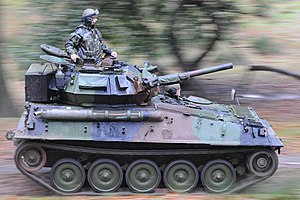Scorpion tank
| FV101 Scorpion | |
|---|---|

Irish Army Scorpion CVR(T)
|
|
| Type | Reconnaissance vehicle |
| Place of origin | United Kingdom |
| Service history | |
| In service |
1973–present (Retired in 1994 by the UK) |
| Used by | Users |
| Wars |
Iran–Iraq War Falklands war Gulf war |
| Production history | |
| Manufacturer | Alvis Vehicles Ltd, Coventry, England |
| Variants | Scorpion 90 |
| Specifications | |
| Weight | 17,800 lb (8.074 tonnes) |
| Length | 5.288 m (17 ft 4.2 in) |
| Width | 2.134 m (7 ft 0 in) |
| Height | 2.102 m (6 ft 10.8 in) |
| Crew | 3 |
|
|
|
| Armour | 12.7 mm welded aluminium |
|
Main
armament |
ROF 76mm L23A1 gun 90 mm in Scorpion 90 |
|
Secondary
armament |
Coaxial 7.62 mm L43A1 machine gun |
| Engine | Cummins BTA 5.9-litre (diesel) 190 hp (140 kW) |
| Power/weight | 22.92 hp (17.3 kW) / tonne |
| Transmission | David Brown TN15 |
| Suspension | Torsion-bar |
|
Operational
range |
756 km (470 mi) |
| Speed | 72.5 km/h (45.0 mph) |
| L23A1 gun | |
|---|---|
| Place of origin | United Kingdom |
| Service history | |
| In service | 1973–present |
| Production history | |
| Manufacturer | Royal Ordnance |
| Specifications | |
| Length | 2.157 m (7 ft 0.9 in) |
|
|
|
| Calibre | 76 mm (3.0 in) |
| Rate of fire | 6 rounds per minute |
| Effective firing range | 2,200 m (2,400 yd) |
1973–present
The FV101 Scorpion is a British armoured reconnaissance vehicle. It was the lead vehicle and the fire support type in the Combat Vehicle Reconnaissance (Tracked), CVR(T), family of seven armoured vehicles. Manufactured by Alvis, it was introduced into service with the British Army in 1973 and served until 1994. More than 3,000 were produced and used as a reconnaissance vehicle or a light tank. It holds the Guinness world record for the fastest production tank; recorded doing 82.23 km/h (51.10 mph) at the QinetiQ vehicle test track, Chertsey, Surrey, on 26 January 2002.
The Alvis Scorpion was developed to meet a British Army requirement for the Combat Vehicle Reconnaissance (Tracked) or CVR(T). In 1967, Alvis was awarded the contract to produce 30 CVR(T) prototypes. Vehicles P1–P17 being the Scorpion prototypes were delivered on time and within the budget. After extensive hot and cold weather trials in Norway, Australia, Abu Dhabi and Canada, the Scorpion was accepted by the British Army in May 1970, with a contract for 275, which later rose to 313 vehicles. The first production vehicles were completed in 1972 and the first British regiment to be equipped with the Scorpion was the Blues and Royals of the Household Cavalry in 1973. In November 1981, the RAF Regiment took delivery of its first Scorpions.
Alvis built more than 3,000 Scorpion vehicles for the British Army, Royal Air Force Regiment and the export market. All of the CVR(T) vehicles were to be air-portable; and two Scorpions could be carried in a C130 Hercules. Another requirement of the CVR(T) project was the low ground pressure - similar to that of a soldier on foot - this would serve it well in the boggy conditions of the Falklands War.
...
Wikipedia
